I love marbled paper and the look it gives books. It’s such an amazing thing, and it’s even more amazing when you realize how long it’s been around. I’ve come to learn that some of the fancy designs I see in paper stores are actually some of the oldest designs out there, the old Middle East and Indian designs from the 15th century are simply incredible.
There are a fair number of people that continue to hand marble paper and even modern objects like bike helmets and even garments but there’s really only a few number of people hand marbling paper in traditional patterns.
Hand marbled paper is so nice, and it’s refreshing to include such a finished aspect in the design of the books I make. It’s typically pretty easy to spot printed marbled paper and even in printed paper from a high quality printer, flaws or mild distortions (like ink rows/bands as it was laid by the printer) can typically be spotted by an untrained eye with only a moments glance.
The thing that is startling to me is that even the fine hand binders don’t typically charge any more for a sheet of marbled paper than you would pay to have it printed from a shop. I’m happy to support the artisans doing this.
I use two marbled paper suppliers, Dodins in Israel and Payhembury in the UK. Both have amazing quality and service at reasonable prices. The marble at Payhenbury is also one of the worlds most respected paper marbling experts and historians and has made books for a few films etc.
Marbled paper is such a fine addition to any book and is always one of my customer’s favorite aspects of the books I bind- I love to take credit for the beauty but it’s absolutely important to note that it’s definitely art, hand crafted, and my only part in the beauty it brings is cutting and pasting it into the book as I would with any other paper.
Endpapers and the development of marbled paper
As with so much knowledge and so many of the skills that lifted Europe in the renaissance, the art of marbling paper originated in China and Japan in the 1100s, but came to the west by way of India and Turkey, where paper marbling began in the 1400s.
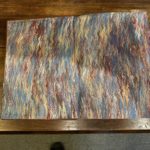
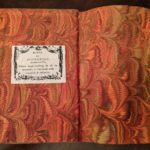
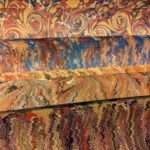
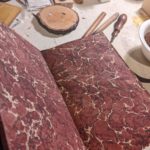
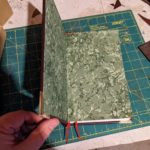
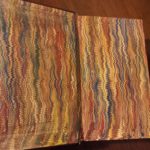
In the early 1500s, marbled paper began to be imported as art, especially by way of “album amicorum” or Friendship Books that were essentially portfolios of collected art combined with small size drawings and paintings made as gifts to commemorate the travels of visitors to the near east.
By the mid to late 1500s this was a trend, and decorative marbled papers began being traded especially in southern Europe in Spain and Italy, but even in northern and as far north as England as early as the 1560s.
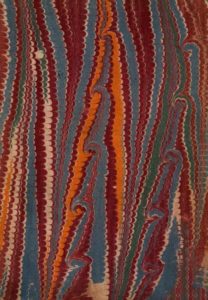
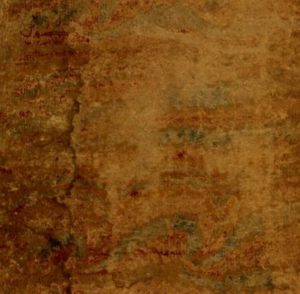
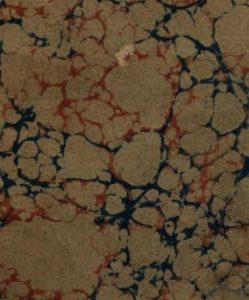
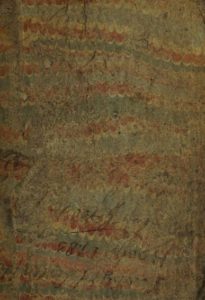
Though rare in western and northern Europe until the mid 1600s, marbled paper began being produced in Germany likely in the 1610s and then spread quickly, by the time of the English civil war, it was readily available but still not commonplace in most publishings.
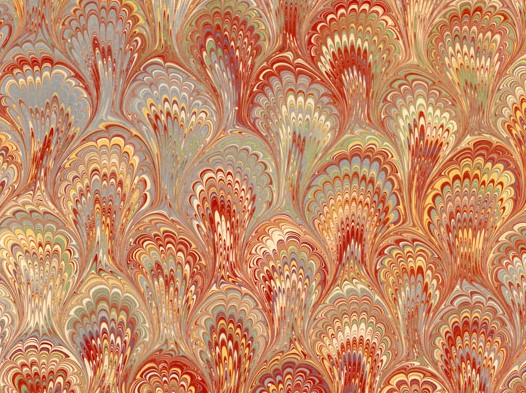
Styles changed, new styles were formed, and early cloud marbling styles and non-parail combed marbled papers became more refined and detailed. Payhembury’s catalog is perhaps the best way to quickly visualize examples and patterns as they changed, and I’ve added a few below as well.
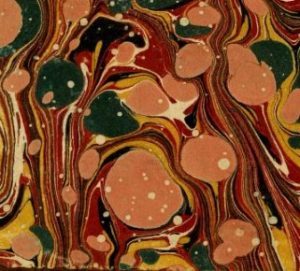
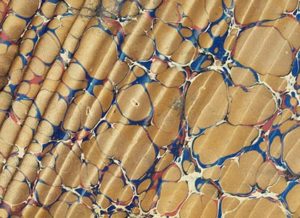
Though there are plenty of beautiful examples of marbled paper in Europe and the rest of the world, collectors of books will tell you that most books printed over the centuries and across cultures do not have marbled end papers, though they definitely become much more common through the 1700s and into the victorian era.
I’m happy to work with you to pick the colors and patterns of your preference for any books you have made through us! Let us know and if we don’t have it in stock we can often order it for you.
Further Reading
- https://www.carnegielibrary.org/discover-historic-bookbinding-marbled-endsheets/
- https://www.vam.ac.uk/blog/museum-life/divers-oiled-colours-exploring-the-history-of-marbled-paper-in-the-national-art-library
- https://livesandlegaciesblog.org/2022/06/22/marbled-paper-the-secret-art-and-function-of-paint-blobs/
- https://ucdculturalheritagecollections.com/2021/02/18/marbled-papers-a-brief-history-of-an-endangered-bookcraft/
- https://archives.collections.ed.ac.uk/repositories/2/archival_objects/16003
- https://www.mun.ca/alciato/album.html
- http://www.oxbowbooks.com/pdfs/books/Ren%20Secrets%20Abrams.pdf
- https://en.wikipedia.org/wiki/Album_amicorum
- https://en.wikipedia.org/wiki/Paper_marbling
- https://www.metmuseum.org/blogs/ruminations/2015/marbled-paper
